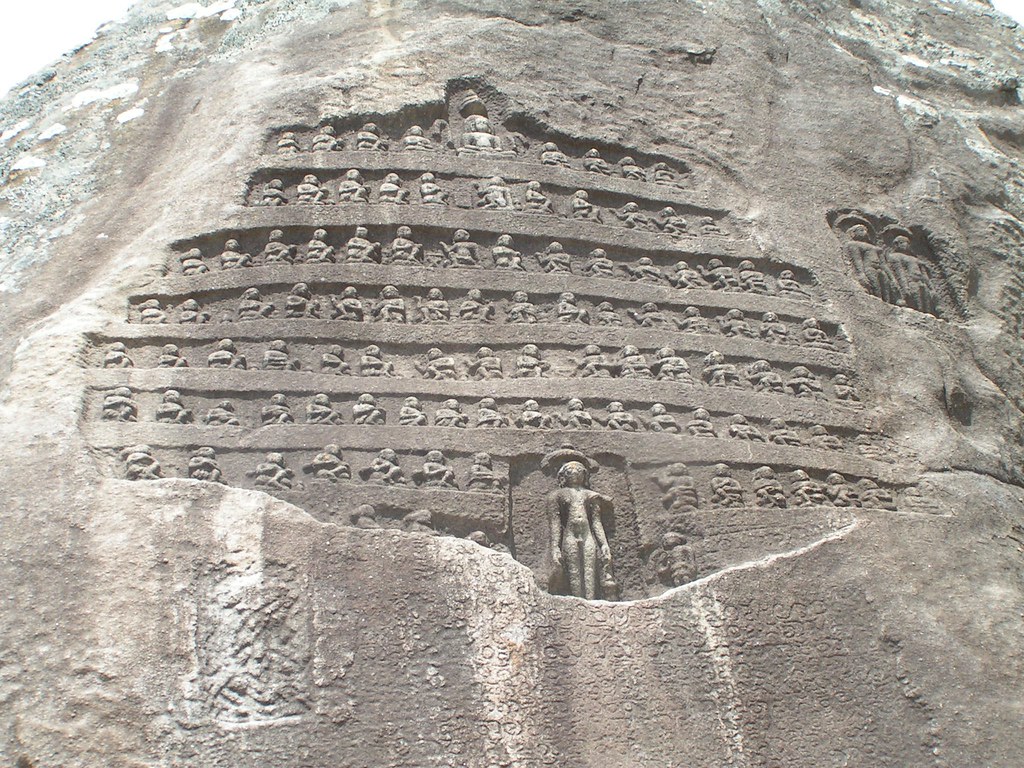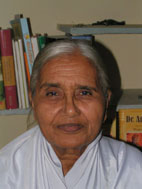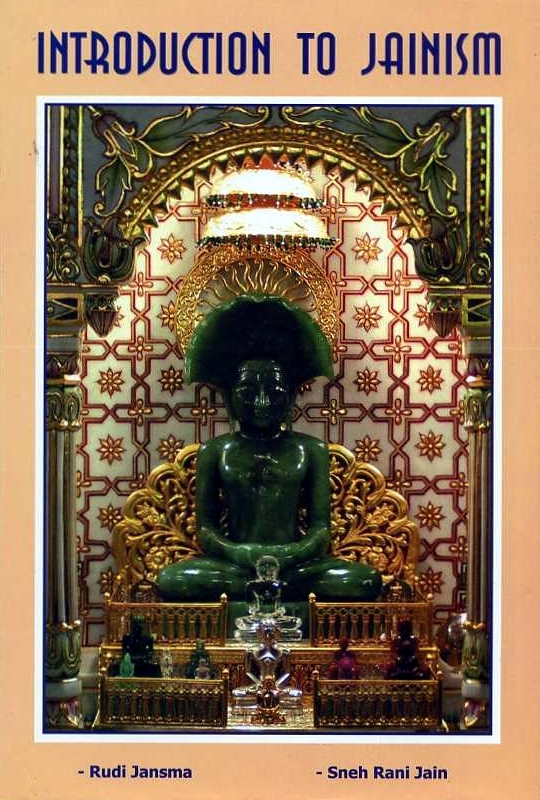Gradually it seems, one started trying better methods on and in the rocks to produce art and preserve it for the future. What is shown on the rocks was later also produced in brass. During In those days the rocks at Vindhyagiri must have been lying in a somewhat different position than they do today, perhaps due to earthquakes or erosion, because it appears that pilgrims originally took a different route to the top. The second phase in the development of art produced images showing a more prominent relief because the rock around the carving was chipped away and the Jinas became more prominent. Apparently the enormous boulders among which the inhabitants found shelter were found the most suitable for durable art. That is why, it seems, the same boulder on Vindhya Hill was used to apply this technique to make the icons clearer.
The Two Brothers
An ever recurring theme in Jain iconography is that of the two brothers. They lived in the period of the 20th Tīrthamkara, Munisuvrata. Their names were Kul-Bhushan and Desh-Bhushan. They were the only two children in the family. When seven and eight, these princely brothers were taken to an ashram for education. They stayed there until they were twenty-five. During this time they had no contact with their parents or other people at the palace where they had spent their early years. When the time had come for them to return, a great party was organized to welcome them. Both the family and the people in the city had prepared a big feast. Ministers were sent ahead to receive Kul-Bhushan and Desh-Bushan outside the city and to accompany them to the palace. In the city there was a joyous and excited atmosphere everywhere when the parade passed by on its way to the palace. In front of the palace their mother and other family members were ready to give them arati - a hand-held copper plate with butter flames, which is turned around slowly before a guest or deity as a greeting. On the balcony of the palace stood a young and very attractive woman who threw garlands of flowers at them. Both brothers at once decided that they wanted to marry her. Independently they shared their desire with a minister. He however did not answer. When both the brothers discovered that the other had the same desire a big argument broke out. It became so fierce that they drew their swords and were ready to attack each other. Then the minister could no longer contain himself, and said: “Stop that nonsense, she is your sister!” “What!” they shouted. “We had no sister!” “When was she born?” And the minister told them that soon after they had left the palace the rooms were filled with the sound of a crying baby - a girl - and this was her. They could not move because of the remorse they felt about the sin they had committed by desiring their own sister. Immediately they both vowed to do uninterrupted penance until they reached the highest enlightenment (moksha). They observed their vow strictly, finally attained moksha, and left their bodies on the Kuntha Hill in what is now the province of Maharashtra, where today we can still see their charanas - carved footprints - engraved in the rocks.
Penitence or penance has nothing to do with a psychological guilt complex or self-castigation. It means that someone takes upon himself the vow to accelerate his spiritual path and to make no more effort to escape his karma. He knows that sooner or later he has to face his karmas anyway. In fact he accepts everything he has to endure with gratitude, for after this his soul has been purified a little more, and his noble qualities can shine forth more brightly. Through his vow and spiritual orientation he brings his karmas to ripeness at high speed and intensity, but his deep trust in his guru, his own soul, and the final goal help him through all difficulties. He opens himself up completely to what comes to him without any resistance, and that is what is symbolized by his standing posture. A sitting posture symbolizes meditation and repentance.
The two brothers, who are also depicted on Indus seals as copies of the original, can be seen in the rocks of Vindhyagiri at Śravana Belagola in their sitting posture of inner meditation as well as their standing posture of penitence - with their peacock feathers and water container next to them on the floor. In the lower part of the sculpture they are depicted sitting with their hands joined, but still as laymen, in preparation for taking their vow. They are still wearing clothes and their hair is knotted sideways in “Indus fashion.” Above this they are depicted naked and standing (photo 14), which signifies that now they have started their lives as holy ascetics. Creepers are growing over their bodies, and their long hair has been replaced by short locks (which in the meantime have already grown again from their bald heads). Above their heads we see one chatra or umbrella, which signifies power of the mundane world - originally destined to become protectors of the people as sovereigns. The stone has been chiseled out around the figures to make them prominently visible.
In the same second style of art the family of Ādināth or Rishabha, the first Tīrthamkara, has been depicted on that rock. His most well-known sons, Bāhubali and Bharata (see chapter 8), have both been portrayed, Bāhubali in standing posture, and Bharata sitting together with his 99 other brothers (photo 15). Close to it we find a sunken relief in the same style depicting Rishabha with a row of monks and nuns.
 Rishabha's family; 2nd phase of art; Vindhyagiri
Rishabha's family; 2nd phase of art; Vindhyagiri
photo 15
Rishabha's family; 2nd phase of art; Vindhyagiri
 Female spiritual person; 2nd phase of art; Vindhyagiri
Female spiritual person; 2nd phase of art; Vindhyagiri
photo 15
Female spiritual person; 2nd phase of art; Vindhyagiri
Rishabha himself is depicted as an arhat (or arahant, literally destroyer of his (inner) enemies) with three umbrellas above his head. Three umbrellas mean that he is sovereign (has knowledge and command) over three worlds: the Middle World (including the earth), the lower worlds and the higher worlds. The best artistic accomplishments in this style are found on the same rock as Bāhubali. Taken as a whole this rock can be seen as a temple. On the backside of the same boulder we find a female devotee, in sitting posture with hands joined (photo 16).
The difference between men and women can not be seen from their hair style, but only from the contours of the breasts, as common in Indus art. This style of art can also be seen on the other hill of Śravana Belagola, “the hill where pious people die,” now called Chandragiri after Emperor Chandragupta Maurya who lived and died there.
One of the Indus seals from Harappa looks like a replica of this place - which again would indicate that this South Indian culture is older than that of Harappa in Pakistan. The same form of art is found in most rock Jinas at remote places in the province of Tamil Nadu (Southeast of Śravana Belagola, which is in Karnataka), and is represented by engravings or relief carvings of the Tīrthamkara Suparśvanāth (the seventh), Ādināth or Rishabha (the first) and Bāhubali, Rishabha’s favorite son described earlier in this book. These signs of the oldest culture in India are now threatened by quarries, which transform sacred rocks into slabs and rubble.
In earlier millennia a great deal of rock art may already have been destroyed by volcanic activity and earthquakes. But the two-storied temple on the Vindhyagiri, which was built on the bedrock, has been preserved. The surrounding structures have collapsed and rolled down the hill. Perhaps there was an ancient effort to save the Key Indus Rock and to keep it in its place, because masons seem to have been working on it. The Bāhubali temple was constructed much later, and in such a way that its roof has destroyed half of the standing “Key Jina.” Apparently nobody cared at the time this temple was built. All this happened long before Parśvanāth (who lived almost 3000 years ago), when the Indus script was still in use. In the period of Mahāvīra (2500 years) the Prakrit languages and Brahmī script were developed. The Rig Vedic Sanskrit came also in use then. But the third stage of Jain art development maintained the use of the Indus script and signs even in that period.
 Dr. Sneh Rani Jain
Dr. Sneh Rani Jain
 Publisher:
Publisher: